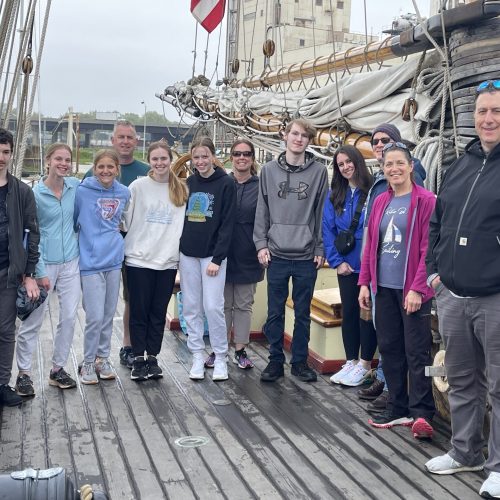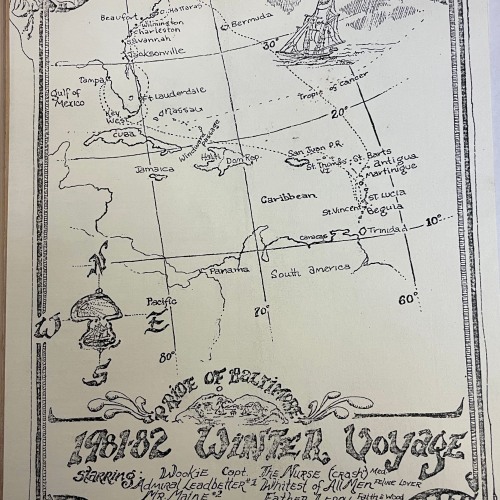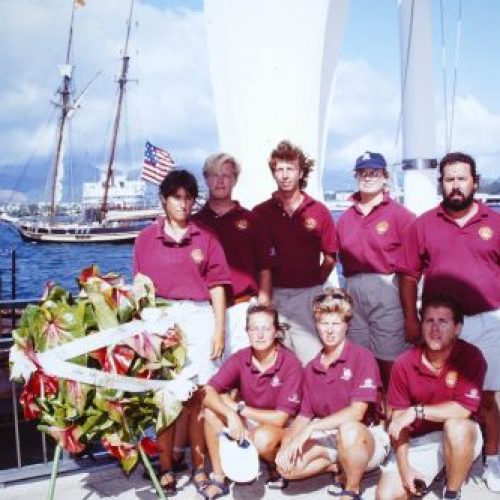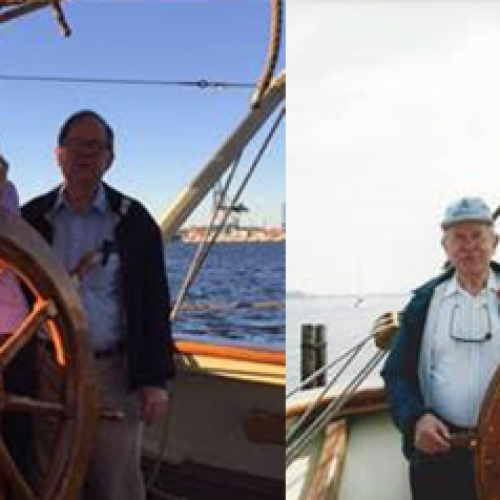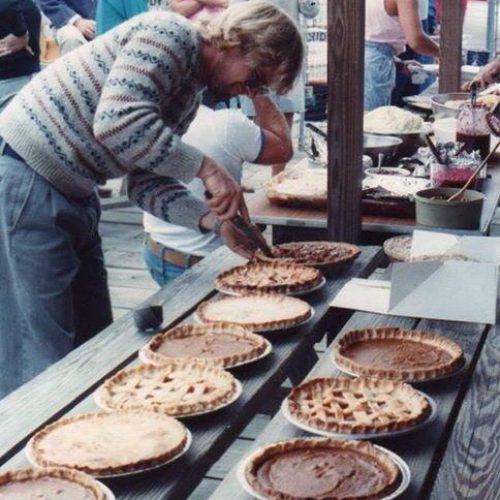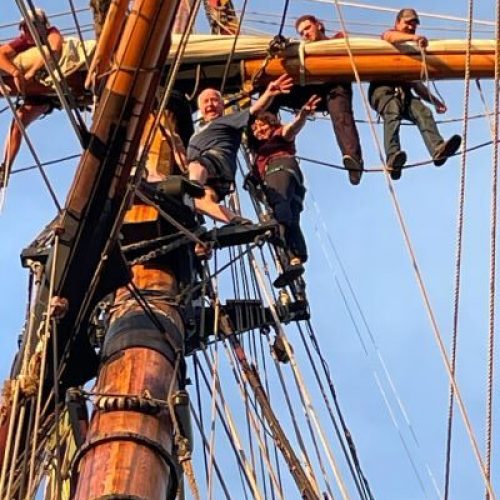 “1st in Class by Pride of Baltimore II in the 24th annual 2013 Great Chesapeake Bay Schooner Race” does not tell the whole story. Among many stories that can be told of this race, one of them is Pride of Baltimore II’s displacement defying performance and the crew that made that performance transpire.
“1st in Class by Pride of Baltimore II in the 24th annual 2013 Great Chesapeake Bay Schooner Race” does not tell the whole story. Among many stories that can be told of this race, one of them is Pride of Baltimore II’s displacement defying performance and the crew that made that performance transpire.
Being first in class does not transmit the fact that Pride of Baltimore II is the heaviest schooner in the fleet yet finished close behind the two fleet leaders and very light displacement schooners, while a full 2.5 hours ahead of any other schooner, and 3.5 hours ahead of the next heavy displacement schooner.
The two lead schooners were America 2.0 and Woodwind. America 2.0 crossed two hours ahead and Woodwind crossed 20 minutes ahead. Both are members of the light displacement large schooner Class A. Pride of Baltimore II is a member of the heavy displacement large schooner Class AA.
For nearly half of the race it was an upwind beat. Pride of Baltimore II made 14 tacks until the wind changed and the race became a reach & run to the finish. During the beat to windward, Pride of Baltimore II held up with the leaders remaining about 20 minutes behind. Pride of Baltimore II continued to keep up with Woodwind for the reach to the finish while both were left in the dust by America 2.0.
So, what about sailing the heavy displacement Pride of Baltimore II to windward? What does it take to hang in with the fastest and weatherly-light displacement schooners? It is only by virtue of Pride of Baltimore II’s sailors, the Crew and the Guest Crew. They did a stellar job of working together, coordinating the complicated shifting of sails from side to side for 14 tacks in a most efficient way, and trimming the shifted sails to best sailing shape. Passing sail quickly meant Pride of Baltimore II spent less time slowed down by tacking. All sailboats tack to windward, the success determining factors: how quickly they do so and how quickly they accelerate out of a tack. Pride of Baltimore II’s crew being quick about passing sail and immediately finding the proper trim meant she could start accelerating sooner. She would still be slower to accelerate than the lighter schooners. An efficient tack and proper re-trimming of sails still meant being quicker than normal – this means the light boats would have less opportunity to stretch their lead by accumulating distance. Pride of Baltimore II’s Crew & Guest Crew kept themselves available for all the tacks rather than loose efficiency by shifting into watches right away, knowing that once the wind change came and Pride of Baltimore II could sail directly down the Chesapeake Bay, they would then be able shift into watches. In the meantime, between tacks they could take a rest.
Displacement is often overlooked by participants & observers of this schooner race. Pride of Baltimore II is almost 190 displacement long-tons (around 420,000 pounds.) If Woodwind weighs 50 tons, that would be around 110,000 pounds. America 2.0 is larger than Woodwind but is very light weight for her size. Maybe she weighs 70 tons (150,000 pounds). Comparatively, both Woodwind and America 2.0 have more sail for their weight than Pride of Baltimore II, but Pride of Baltimore II has more sail area overall. There are other aspects of difference as well. They are of less beam than Pride of Baltimore II’s 26 feet at her waterline of 91 feet. For sure Woodwind is a lot narrower than Pride of Baltimore II. I suspect the same is so for America 2.0. The beam to length ratio for Pride of Baltimore II is 0.28. In other words Pride of Baltimore II is nearly a third her length wide. Chances are Woodwind and America 2.0 have ratios that are smaller than Pride of Baltimore II – this meaning they are likely narrower for their length than Pride of Baltimore II is. Draft for both would be substantially less than Pride of Baltimore II’s 12.5 feet. While it is much easier to notice Pride of Baltimore II has a lot of sail area and is indeed longer, when one factors in weight, it becomes pretty easy to understand why the lead vessels of Class A would generally be quicker to accelerate than Pride of Baltimore II.
Pointing to windward is a key factor for racing. Different vessel designs have different abilities to point to windward. Most of the windward pointing ability a boat has is in the shape of the hull. A barge can have a very windward capable sail plan to sail with but will still be unable to slip through the water nicely to achieve actual windward ability due to the square and shallow shape of the hull. The light displacement Class A boats are all designed with slim hulls that get narrower still down deep, hence providing little resistance to sliding forward. The most modern schooners of today have canoe hulls with fins attached underneath, like wings are to an airplane fuselage. These vessels are more easily driven through the water than the already easily driven narrow hulls of older style yacht schooner designs, and they can also accelerate rather quickly. If their wing-like keels are really small for their size of hull and sail plan they may go really fast when the wind is a reaching or running angle, but they won’t be able to point as well to windward. Due to being so small, they drift sideways more than those with bigger winds. Although, they will be able to sail fast while not pointing so close to the wind. It was interesting for me to observe Woodwind out point America 2.0 while America 2.0 sailed faster. Meanwhile Pride of Baltimore II was sailing closer to the wind than America 2.0 but not as close as was Woodwind, while Pride of Baltimore II was sailing about as fast as Woodwind but not as fast as America 2.0. These differences forced America 2.0 to sail more distance faster than Woodwind or Pride of Baltimore II; all three vessels stayed pretty close to each other at the front of the fleet during the beat to windward. Then, when the wind changed to a reach, Pride of Baltimore II’s longer waterline length made for good speed to keep up with Woodwind’s narrow hull, even narrower keel and overall very light weight, while America 2.0 slipped away into the distance with her canoe hull, wing keel and even lighter weight for her size.
In the end though, as it has been for 25 years, it is Pride of Baltimore II’s crew that make the final difference (and always have for all the successful racing Pride of Baltimore II has done.) This year 1st Mate Will Mclean did a fantastic job teaming up with 2nd Mate Barbara Krasinski and Bosun Drew Salapatek to create good organization of the rest of the Crew & Guest Crew. These young officers organizing, everyone’s willingness and strong hearts, made Pride of Baltimore II tack much quicker than I have seen all this year (largely due to a successful experiment for passing sails more simultaneously than normally done.) By keeping all hands on deck until all of the tacking was done, the crew had enough power to manage simultaneous passing of Pride of Baltimore II’s many loose footed sails – something we do not normally do because of normally being on watches for voyages, hence not having as many persons on deck. Once the wind change came and Pride of Baltimore II was reaching down the Chesapeake Bay right behind the two leaders, the crew went into watches and started to get rest. When Pride of Baltimore II “reaches” there is no tacking and no regular, significant sail adjustment; there is only steering and keeping an eye on things, or striking or setting sail based on rise or fall of wind strength. To keep the crew energy up Pride of Baltimore II’s Cook Kit Cusick did a bang up job of laying out plenty of food and keeping it available for snacking all race long, especially during the night after a fantastic supper. Kit also was on deck helping out very beneficially with the tacking.
So, who were all those hard working Pride of Baltimore II Crew and PRIDE Guest Crew that had such heart & grit to keep all of those 14 tacks as quick as possible? In addition to the officers mentioned above there is: Chad Lossing as Engineer/Deckhand. Kit Cusick, Ship’s Cook. Deckhands Nate Hathaway, Sam Hilgartner, Brittany Mauer, Rebecca Prasher, Lydia Mathewson and Jesse Wiegel. Pride of Baltimore II Guest Crew were Jeannie Poole & Jim Hilyard. Both old hands having been aboard multiple times for voyages in various parts of the globe. And Guest Crew new comers Curt Keim, Eric Heinbaugh and Rick Prothero. Everyone contributed greatly to sailing Pride of Baltimore II so she could finish the race along with the fast, light weight boats. Wowing all who observed by doing so, while still being representative of the vessels of Baltimore’s schooner privateers of the 1812 War and the reason why the British Navy came to attack Baltimore so as to burn the shipyards building the remarkable Chesapeake Bay schooners so they could no longer be effective privateers.
Jan C. Miles and the gung-ho racing crew of GCBSR Class AA 1st place finisher, Pride of Baltimore II

